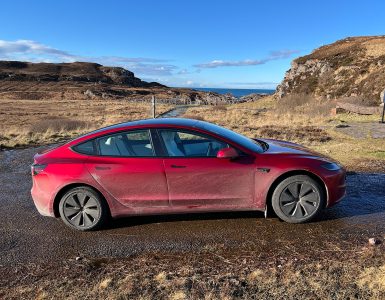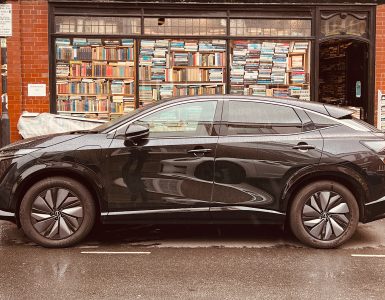OK so when you hear the suggestion that Tesla could learn something from the new Citroen Ami EV you may doubt my sanity. After all, it boasts looks that only its own mother could love while a tiny 5.5kWH battery still takes 3 hours to charge and delivers a top speed of 28mph and a range of 48 miles. If it was Citroen’s aim to cut specs to the bare essentials they have succeeded.
While the press coverage has centred on how the Ami can be driven in France by 14 years olds without a full licence that is not what makes this car important.
Cutting Specs down to a single use
Have a quick look at this video from Citroen and things start to become clearer
Ok so hopefully the sharp eyed amongst you noticed a few of the ruthless cost saving measures Citroen has employed to get the price down to around £5,000 for this electric car.

- Its not a car! Yes it actually fits into the Quadricycle category of extra small vehicles with limited performance that allow it to be driven on the same sort of L plates as a moped
- Did you notice all the optional colours? Citroen actually only offer the car in a single colour.. yes 1 which is why the ad frenetically swaps background colours instead!
- the car is not painted at all! Yes that grunge blue is a pigment that is part of the panels when they are made.. so no paint shop needed
- Did you notice the sat nav? You guessed it – there isn’t one but download the app and the Ami uses your own phone (there is a spot on the dashboard where you can plug in!)
- Did you notice the doors? On one side they are hinged like a normal car at the front.. but on the other side they are hinged on the back.(rather cruelly known as suicide doors because if opened when moving they fly open). So was this to be quirky? Nope.. they are the same door..so one machine can be set up to make left and right doors
- Did you notice how the front at back look similar? Yup you guessed it..t the Dr Doolittle push me pull me look is because they are identical – one end has headlamps and the other has rear lights. The indicators are the same.
- Isn’t the back different.. look at the shape? Nope.. they are in fact so identical that Citroen stuck a large plastic spoiler over the back so you can tell which way the car is facing!
- How does the rear hatch open if the front and back are the same? You must be catching on by now… there is no rear hatch or opening other than the side doors..
- But surely it has a radio? Nope no radio or speakers.. but it does have room to put place your own bluetooth speaker and connect it to.. your own phone!
- So how do some models look different? well they do have some variants that have.. bumpers..and different wheel covers… and there is a sticker book with stickers you can place on the car. Some rental cars also seem to have some wraps to make them look different.
Ami Cost per mile compared to a Model 3
So Citroen have just cut the spec to the minimum to make more profit? Well no, its delivered a budget EV perfect for city car sharing that costs just over £5,000 or around 24p a minute when combined with a monthly subscription of around £9 a month.
Although a Tesla Model 3 is seen as expensive it offers better value as a cost per mile of range than many other EV’s. This stripped down little Citroen delivers value too.. in fact per mile of range it’s a third cheaper than a Model 3 in the UK.. if the Model 3 was priced at the same cost per mile it would cost…£26,740.
| Tesla Model 3 SR+ | Citroen Ami | Smart Fortwo coupe | |
|---|---|---|---|
| Car | |||
| Range (WLTP mls) | 254 miles | 48 miles | 81 miles |
| Charge time | 20 mins 170 kW | 3 hours | 40 mins 22kW |
| Top Speed | 140 mph | 28mph | 81 mph |
| 0-62 mph | 5.6 secs | around 10.7 secs to 28 mph | 11.6 secs |
| Battery size | 50 kWh | 5.5 kWh! | 17.6 kWh |
| Personal lease per month | £491 per month+ £1,472 | £17 per month + £2,227 0r a flat €0.26 per min +€9.90 a month | £150 permonth + £1,350 (drive electric) |
| purchase price | £40,490 | €6,000 (£5,054) | £17,730 |
| Purchase price per mile of range | £159.40 | £105.29 | £218 |
Obviously a Model 3 with no tech or equipment, a dubious level of crash & other safety and a top speed of 28mph be stripping things down too far. But for a city shared rental car have Citroen got the balance right?
Well there is a vast gap between the capabilities between the tour de force that is the Model 3 and the plucky Ami.
How about the Smart Coupe though.. is it really worth (before UK grant) 4 times the price of the Citroen? The Smart delivers 2x the range of the Ami and conforms to full car crash safety requirements. Citroen has hopefully been designed to survive city speed impacts but we don’t know. All Citroen say its a safer alternative to bicycles and mopeds.
What the Citroen has done is set one very extreme side of the goal posts. What if the Citroen was a little less extreme and for 50% to 100% more .. (£7,500 to £10,000) came with
- full crash safety
- 7.2kW charging (taking charge time from 3 hrs to around 40 mins)
- a pop up roof for better ventilation in summer
- A solar charging panel like the German Sion car. While the Sion is a bigger car and has more space for solar panels the Citroen counters with efficiency and light weight. Could a rental Ami with solar Panels add 21 miles of range per day like the Sion claims it will? For many drivers it wouldn’t have to. 10 miles added per day would for many be enough to offer a car that goes off grid with free power. It would still represent fantastic value.
So why is the Citroen Ami important?
- Finally instead of justifiable moaning about EV’s being more expensive than piston cars.. here is one that is cheaper to buy or use in a car sharing service
- While it would be hopeless and probably dangerous on long trips for 90% of trips in towns it is enough. Basic but fun.
- Finally, and most importantly it is to my mind the first radical illustration of a trend that become very big between now and 2030 – vehicles designed for a single role.
Passenger car design for a specific Role
Lets take the example of the Tesla Model 3 and the plans for self driving “Robotaxis” that you’ll be able to call up via an app whenever you want. The economics of this along with the coming together of EV, autonomy & clean energy tech combined with the ride sharing business model in my view make this inevitable as outlined by Tony Seba here.
Elon Musk and Tesla are well on the way to achieving this. The question then is..if you’re standing by a train station would you be better served by a Model 3 Robotaxi showing up every time for any journey or a vehicle that’s chosen based on your journey
Journey types
Low speed City or urban trips
Spec: easy access, upright bench seating, easy to clean interior that could put passengers in a pod with compartments. Different passengers going in the same direction could maintain safety and privacy but be carried in the same vehicle or be small “single pod” units the size of an Ami.
This could be as utilitarian as a Citroen Ami in self driving form although with good safety or it could be high tech. The key thing is it will be lighter & more efficient for local journeys & easy to enter and exit quickly.
It doesn’t need to be aerodynamic in city form because it will be for inner city units where speed limits are 20-30mph and traffic speeds are nearer 10mph. It does need to be compact as autonomous EV’s could increase actual car passenger miles.. if they are all enormous and still mostly just carrying one passenger traffic gridlock will be worsened.
Medium and Longer distances or high speed journeys usually between 30 mins and 6 hours
Spec: needs good range, performance, safety and comfort. A Tesla Model 3 or Y is ideal for this multi role with plenty of space for passengers and luggage. They could be a little smaller and more slippery for single occupancy. like an Aptera.
Long distance luxury travel for 2 to 8 people for 3 to 24 hours
Some people today spend 365 days a year in a big SUV, saloon or estate because a handful of times they use a car on long journeys like London to Cornwall or Scotland or to ski in Europe.
Imagine if your car service delivered self driving smaller vehicles for shorter trips but on long distance trips offered spacious comfort that allowed you to sleep on the way, carry all you need or watch films or travel in a living room environment where people can work or chat. It would be much more like a luxury air or train service.
Why tailor vehicle design?
While some people will always want to travel in a big luxury vehicle the fact is driving a oversized behemoth like an “Audi Q7” because it is “just right” for 10 trips a year while being much too big & a waste of resources and money for daily use makes no sense. Small vehicles on the right trip can also be more fun.
However self driving “robotaxis” from a fleet could end this compromise. Self driving fleet cars won’t need to try and deliver a swiss army knife of use options. They are able to solve the 3 use scenarios of short urban journeys, medium trips and long distance journeys in comfort you can basically outperform any fossil burning car or short to medium distance plane on any one task. While it won’t replace mass transit bus & train travel it would also transform access to travel regardless of age or income in areas only currently served by an infrequent bus or train.
It does have to be efficient in both capital spend and running cost for the different use cases. For example a city pod vehicle could be optimised for what to do when sitting in traffic. In ultra slow moving traffic (some journeys could be down to 2mph) in London my Model 3 can end up using over 400 Watt hours per mile in winter and over 300 in summer.. far more than even at 70 mph motorway speeds.
Tailoring vehicles for a single purpose is not new
This English stately home had an “Ami” for a going to tea at the vicarage down the lane, and a “Model 3” pulled by a full set of horses for long distance travel
There isn’t much a Citroen Ami can teach Elon Musk as a vehicle and he probably has this suite of vehicles approach in planning already but Citroen has shown single role utility can be cool and fun. If it means a few more people in France catch a train and use a little “Ami” EV to get themselves and a suitcase to their end destination with a tiny CO2 footprint, all the better.









[…] next year the cheapest EV (technically not a car) will be the Citroen Ami which should sell for under £6,000 when it launches in UK next year. It is more an urban […]